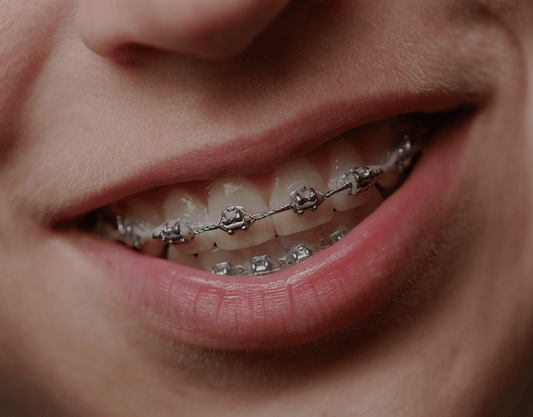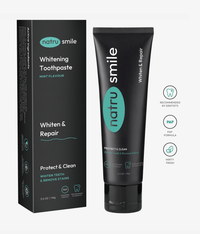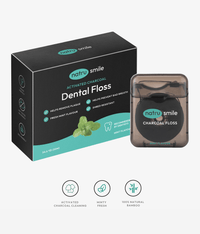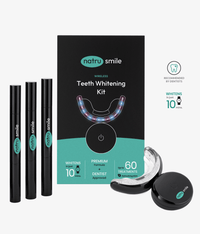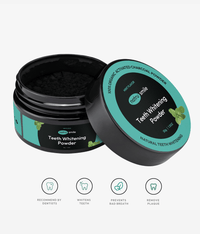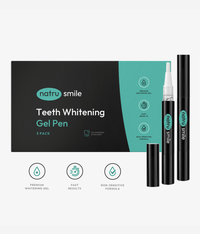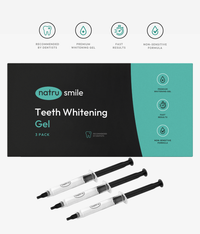
All products are certified by dental expert Dr. Greg Grillo
Braces, dentures, and chipped teeth can bring with them complex feelings. We tie a lot of our identity to having a perfect, shining smile. No one should have to deal with extreme pain and discomfort to achieve that.
If you're plagued by mouth ulcers, braces, or dentures that cause discomfort, dental wax can be a great solution. Also known as orthodontic wax, tooth wax, or braces wax, it’s an easy-to-use product that can help to protect your teeth and gums from further irritation.
With the proper use of dental wax, you can reduce any pain in your mouth, and keep your teeth and gums healthy. Improving your smile shouldn’t lead to ulcers, and with wax, it doesn’t have to.
What Is Tooth Wax?
Dental wax is a special type of wax that's specifically designed to protect your teeth and gums. It's soft, pliable, and easy to apply.
You can put it directly onto any orthodontic hardware in your mouth to hold it in place or soften the edges of metal or ceramic brackets. As it hardens, it forms an invisible barrier between the braces or dentures and your mouth tissue, preventing any further irritation.
Plus, its soft texture makes it perfect for making sure that your orthodontic hardware stays secure in place, so you can rest assured that your smile will stay looking its best.
How Does Tooth Wax Work?
Tooth wax works by providing a barrier between the braces, dentures, or broken tooth and your mouth. As you apply it, it forms an invisible layer of protection that prevents any further irritation from occurring.
It also helps to reduce friction, which can help to reduce pain caused by braces or dentures rubbing against your gums and other sensitive areas in your mouth.
Made from all-natural ingredients like paraffin wax, beeswax, and carnauba, dental wax is a safe and easy way to take care of your oral health from home. It will slowly break down within your mouth but stays smooth and harmless until you reapply.
What Is Tooth Wax Used For?
Tooth wax is truly the jack of all trades when it comes to oral health. It can be used for several different things, including protecting the mouth from hardware, protecting chipped or broken teeth, and holding dentures in place.
Dental wax is often used to provide relief from mouth ulcers, braces, or dentures. It can also be used to protect gums and other sensitive areas in your mouth that are prone to irritation.
When you have new orthodontic hardware or dentures, it takes some time for your mouth to adjust to the new sensations. Over time, your cheeks and gums will adjust, but until then dental wax can smooth over any sharp edges or awkward pieces.
Over time, dentures may start to fit incorrectly. Replacements can be expensive, so dental wax can help give you peace of mind until you can get them.
Because it’s soft and natural, dental wax won’t damage your dentures. In extreme cases, dental wax can even hold broken pieces of dentures together.
If you chip or break one of your teeth and find that a sharp edge is irritating your mouth, dental wax can provide some relief until you can visit your dentist. This will only work if the break is small because it might cause more damage in extreme cases.
How To Use Dental Wax For A Broken Tooth
If you've ever broken a tooth, then you know how painful it can be. Dental wax can be a great way to temporarily curb the pain. Ultimately, you should seek medical attention as soon as you notice a broken tooth.
Broken teeth can range from a slight chip up to a full shatter reaching the tooth’s center. These major breaks can reach blood vessels, nerves, and connective tissue.
If a minor break is irritating your mouth, that’s where dental wax can help. It provides protection from decay, reshapes your tooth, protects your mouth from sharp edges, and helps with any sensitivity.
First, clean the affected area with warm water. Don’t brush the tooth or clean it too rigorously, as this may cause more damage. Take some dental wax on your finger or a q-tip and apply it to the broken edges of your tooth.
Make sure that all areas are completely covered so that no food particles can get stuck in between them. This will help protect your gums from further irritation and provide relief from any pain or discomfort associated with the breakage.
Do what you can to not chew with the broken tooth, and avoid it when flossing. It’s vital that you get a dentist’s opinion on any broken or chipped teeth to ensure they are taken care of fully.
Using Dental Wax On Braces
While it would be nice to straighten teeth without braces, sometimes a little more hardware is required to get that perfect smile.
If you wear braces, dental wax can also be used to provide some relief from the irritation caused by them. While your teeth hurt with braces, your mouth doesn’t always have to.
It’s unavoidable that braces will rub your mouth the wrong way. As your teeth shift, the wires will move and may poke at the back of your mouth. Dental wax allows you to ease this pain until your next orthodontist appointment.
Before applying the wax, make sure that all brackets and wires are clean and free of any food particles or debris. You’ll want to thoroughly wash your hands to prevent the spread of bacteria.
Then, take a small amount of wax on your finger, roughly the size of a popcorn kernel. If you try to use more wax than that, it’s likely to fall off. Roll the wax between your fingers for at least five seconds. This will soften the wax and make it easier to mold.
Use your fingers to find any areas that are causing pain. You’ll likely find a wire sticking out or a particularly sharp bracket. With a tissue, dry off your braces as much as possible to insure the wax sticks for a long time.
Stick the ball of wax into place, and rub it smooth. Once it’s in place, the wax will allow your mouth to heal, and you can look forward to your next dental appointment.
When you speak with your dentist about the process of getting braces, braces costs, and care, they will likely bring up dental wax and explain how to use it.
How To Use Dental Wax For Dentures
If you wear dentures, dental wax can also be used to provide extra cushioning and protection, as well as to keep the dentures in place if they get a little loose. Over time, general wear and tear can shift your dentures out of shape, and having any foreign object in your mouth has the potential to irritate.
Before applying the wax, make sure that the area is clean and dry. Whether you’re using it as a barrier or an adhesive, the wax will stay in place longer if it’s applied to a dry surface.
Make sure that you’ve warmed up the wax by rolling it in between your fingers before applying it. Then, take a small amount on your finger and apply it directly onto your denture. Spread it evenly so that no area is left unprotected.
If your dentures are broken or don’t fit properly anymore, you must contact your dentist to get the issue sorted out. Even with dental wax, eventually they will cause more harm than good.
What To Watch Out For When Using Dental Wax
While dental wax can be a huge relief for anyone dealing with sores in their mouth, there are some things to keep an eye out for when you use it.
One of the biggest challenges with using dental wax is that it can be prone to melting or becoming sticky if exposed to heat or moisture. To avoid this, make sure that you store your dental wax in a cool and dry area away from direct sunlight.
Additionally, try not to apply too much wax, as this can cause clumping and make it difficult to remove later on.
Even though the wax is made of natural materials, you should avoid swallowing it. Its sticky nature can lead to blockages and digestive issues. This is part of why it’s important not to eat or drink while wearing dental wax.
Don't wear the wax for too long as this can cause bacteria to breed, increasing your risk of infection. Replace the wax at least every two days.
As with anything related to your oral health, it’s important to make sure you fully understand dental wax before using it. Here are some frequently asked questions.
Where To Buy Dental Wax For A Broken Tooth?
Dental wax is available for purchase at most drug stores or online. You may be able to find an over-the-counter temporary kit designed specifically for dealing with a broken tooth.
If you have a broken or chipped tooth, dental wax can be used to cover and protect the area. This is a temporary fix, and should only be used until you go in to see a dentist.
Additionally, if your broken tooth is severely damaged and has an exposed nerve or copious amounts of blood, it's best to seek professional help from a dentist before using any type of wax.
What Is Orthodontic Wax Made Of?
Orthodontic wax is typically made from a combination of beeswax and paraffin. This provides the wax with a soft, pliable texture that can be easily molded to fit the shape of your teeth or braces.
Although these are natural ingredients, it’s important that you avoid ingesting dental wax, because it can lead to blockages and other digestion issues. As the wax breaks down, make sure you are taking it out and replacing it.
What Kind Of Wax Can I Put On A Broken Tooth?
Most dentists recommend getting to a dentist as quickly as possible if you have a chipped or broken tooth. However, if that isn’t an option, wax can be a good temporary fix.
You can use any type of dental wax, such as paraffin wax. It can be found at any pharmacy, usually in an over the counter kit designed specifically for temporarily protecting a broken tooth.
How Long Can I Use Dental Wax For A Broken Tooth?
Dental wax is a great way to temporarily protect your mouth and teeth after a broken or chipped tooth. However, this fix can not be long term.
There is always a chance that bacteria gets beneath the wax and leads to more serious issues down the line. Ideally, wax will be used for only a couple of days, until it is possible to get an emergency dental appointment.
Wax will never be as effective as a filling, crown, bonding, or veneer.
How Do You Get Dental Wax To Stick To A Broken Tooth?
The best way to get dental wax to stick to a broken tooth is by gently warming it up with your fingers. This will soften the wax and make it easier for it to adhere to the surface of your tooth.
Make sure the surface you are adhering it to is as dry as possible. Any moisture will make the wax melt. Don’t use more wax than you need. A piece the size of a popcorn kernel should cover most issues.
How Long Does Dental Wax Last?
You should replace dental wax inside your mouth every two days at least. While you can eat and drink with the wax on, it’s important that you avoid swallowing it. Any food or debris caught in the wax can cause serious issues.
Although dental wax can last up to a year if stored correctly, it is recommended that you replace the product after three months of use. Over time, the wax may become brittle or sticky due to changes in temperature or humidity, which could affect its ability to provide protection.
Can You Eat With Dental Wax?
While you can eat with dental wax, it’s not recommended. This is because the wax can collect food particles and debris, which breed bacteria.
Additionally, small pieces of the wax could break off and be swallowed, which can cause digestive issues. You shouldn’t be worried about ingested dental wax, as it is made with natural ingredients, but it should be avoided if at all possible.
Can I Sleep With Dental Wax On?
Yes, you can sleep with dental wax on, and it’s encouraged by dentists that you do. The pain that dental wax is preventing can lead to restless nights, and more damage to the inside of your mouth and gums.
If you choose to use dental wax for nighttime protection, make sure that the wax is not too thick, as this can make it difficult to keep in place. Also, ensure that you clean your teeth and gums thoroughly before applying the wax.
Can You Use Dental Wax On A Broken Filling?
Yes, dental wax can be used on a broken filling. However, you should make sure that the area is completely dry before applying the wax and ensure that there are no pieces of the filling remaining in your mouth.
Dental wax should only be used as a temporary solution for a broken filling because it can still allow bacteria into the cavity. Make sure you make an appointment with your dentist any time you notice an issue with your fillings or crowns.
Can I Use Dental Wax Every Day?
Depending on the situation, you can wear dental wax every day. Many people use wax the entire time they wear braces to minimize discomfort. It can also be used to keep dentures in place. Make sure you replace your wax every day or two, and you’ll be all set.
However, if you are using dental wax to protect a broken or chipped tooth, it should only be worn for short periods of time. Dental wax should never be used as a substitute for regular dental care or treatment from your dentist.
Does Dental Wax Dissolve?
No, dental wax is not designed to dissolve. As you wear it, it will start to flake off and peel away. That’s why it’s so important that you continue to replace it every day or two.
Because dental wax doesn’t dissolve, it can be difficult for your body to digest.
Do your best not to swallow any wax.
Heat and moisture can cause the wax to melt, so keep an eye on your wax if you are consuming any hot foods or beverages.
Does Dental Wax Melt?
Yes, dental wax can melt if exposed to heat or moisture. To avoid this, make sure that you store your dental wax in a cool and dry area away from direct sunlight.
Additionally, try not to apply too much wax as this can cause clumping and make it melt away from your teeth.
Is Orthodontic Wax Safe To Swallow?
You shouldn’t be too worried if you swallow dental wax. The ingredients are all natural, and likely won’t cause any damage. However, it’s recommended that you do your best not to ingest it.
The reason for this is dental wax’s sticky nature, and the fact that it does not dissolve. It can cause blockages and digestion issues. These are rare, and usually mild.
What Does Orthodontic Wax Taste Like?
Orthodontic wax is a type of dental wax used to cover braces and other dental appliances. Often times, it’s tasteless, but some manufacturers will add flavors for comfort.
The flavor can vary from brand to brand, but is usually faint. The most common flavor of dental wax is mint.
Will People Be Able To See The Orthodontic Wax When It’s On My Braces?
No, dental wax is designed to blend in with the color of your braces and teeth, so it's unlikely that people will be able to tell you're wearing it.
This means that dental wax doesn’t only protect your lips, cheeks, and gums from irritation, but it’s subtle. This allows you to feel confident and comfortable while you move towards that perfect smile.
Wax will not cover up any brightly colored braces elastics that you choose, so you can protect your mouth while expressing yourself.
You want to make sure that the only color on your teeth is the color you choose, so take care and use whitening toothpaste and brushes to get rid of yellow teeth with braces.
Are There Any Alternatives To Orthodontic Wax?
Although orthodontic wax is a great option for protecting your mouth, there are other alternatives that may be more suitable in certain situations. For instance, dental silicone is available in a strip or dot that you can easily apply to your teeth. It’s transparent, and less sticky than dental wax.
Another option is beeswax. Because it’s used to make dental wax, it can be a great alternative if you run out of dental wax and need a quick fix.
Conclusion
Dental wax is a versatile and useful product that can help reduce soreness and discomfort in the mouth caused by braces, retainers, dentures or other orthodontic appliances.
With its easy application and low cost, dental wax is an excellent tool for those who need to protect their teeth from irritation. Whether you use it to cover sharp edges on your braces, hold your dentures in place, or protect a chipped tooth until you can get to the dentist, it can be a great addition to your oral health routine.

